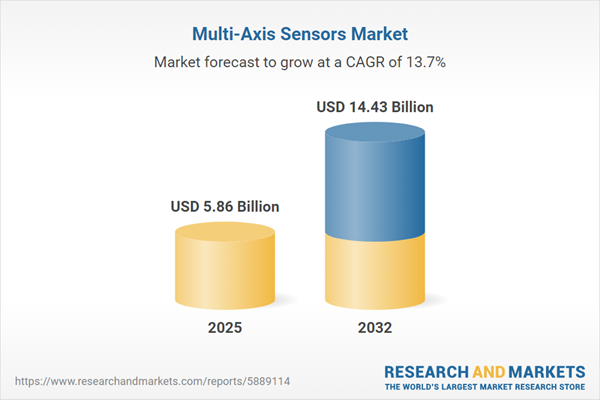Speak directly to the analyst to clarify any post sales queries you may have.
The multi-axis sensors market is evolving rapidly, driven by demand across automotive, industrial, and consumer applications. Senior decision-makers require actionable insights to navigate shifting regional policies, technology innovations, and competitive landscapes.
Market Snapshot: Multi Axis Sensors Market Growth & Outlook
The Multi-Axis Sensors Market grew from USD 5.15 billion in 2024 to USD 5.86 billion in 2025. It is projected to advance at a CAGR of 13.72%, achieving USD 14.43 billion by 2032. Key growth drivers include technological integration, rising adoption in automotive and industrial sectors, and ongoing innovation in MEMS and sensor fusion frameworks. The market’s expansion is further fueled by increased automation, connected devices, and heightened regulatory awareness in sectors such as healthcare and aerospace.
Scope & Segmentation of the Multi Axis Sensors Market
This report presents a detailed analysis of the market by breaking down critical segments and coverage:
- Application Segments: Automotive (ADAS, airbag deployment, vehicle stability control), consumer electronics (smartphones, tablets, wearables), healthcare (biometric devices, medical imaging, patient monitoring), industrial (predictive maintenance, process control, robotics)
- Technology Types: Accelerometers (MEMS, piezoelectric), gyroscopes (fiber optic, MEMS, vibrating structure), magnetometers (anisotropic magnetoresistive, fluxgate, Hall effect)
- Axis Number: 2-axis, 3-axis, 5-axis configurations for application flexibility
- Sensor Types: MEMS, piezoelectric sensors to suit diverse performance demands
- End-User Industries: Aerospace & defense (commercial and military), automotive (OEM, aftermarket), healthcare (homecare, hospital), industrial (energy & utilities, manufacturing)
- Geographical Regions: Americas (North America, Latin America), Europe, Middle East & Africa, Asia-Pacific (including leading and emerging economies)
- Leading Companies: STMicroelectronics N.V., TDK Corporation, Bosch Sensortec GmbH, Analog Devices, Kionix, Murata Manufacturing, TE Connectivity, Honeywell, Sensata Technologies, NXP Semiconductors
Key Takeaways for Multi Axis Sensors Industry Leaders
- Acceleration in motion detection technologies is transforming use cases for automotive safety, healthcare diagnostics, and consumer device interaction.
- The integration of advanced sensor fusion, edge computing, and miniaturization supports innovative products without sacrificing design integrity or energy efficiency.
- Flexible substrates and energy-harvesting advances allow broader sensor deployment across new form factors, including wearables and curved or dynamic surfaces.
- Global and regional players leverage strategic alliances and M&A activity to manage intellectual property and R&D challenges in this highly competitive space.
- Diversification of supply chains and regional manufacturing supports resilience in the face of regulatory changes and tariffs impacting component sourcing.
- Targeted segmentation enables stakeholders to align investments with sector-specific demand, maximizing ROI through differentiation and tailored product development.
Tariff Impact on Multi Axis Sensor Supply Chains
Recent changes to United States tariff policy are impacting procurement strategies, prompting companies to re-evaluate sourcing and logistics models. Adjusted duties on semiconductors and electronic components have led to increased nearshoring and regional assembly, reducing risk from fluctuating tariffs and safeguarding delivery timelines. These disruptions are prompting new long-term agreements and heightened focus on domestic manufacturing, which is expected to enhance market resilience and promote local innovation.
Methodology & Data Sources
This report uses a combination of structured executive interviews, design and procurement expert insights, and comprehensive secondary research. Technical publications, patent filings, regulatory notices, and public financial disclosures inform the analysis. Triangulation of quantitative and qualitative data, scenario workshops, and peer review reinforce analytical validity.
Why This Report Matters for Senior Decision-Makers
- Delivers clarity on the evolving global and regional market, providing actionable intelligence for strategic planning.
- Maps technology trajectories and regulatory shifts to help organizations preempt market risks and harness emerging opportunities.
- Enables leaders to benchmark against competitors and define differentiated product strategies targeting high-growth segments.
Conclusion
As multi-axis sensor technologies blend with smart materials, edge analytics, and dynamic regulatory frameworks, industry leaders must stay alert to innovation and market transformation. Strategic segmentation, supply chain agility, and collaborative development will drive value capture in this evolving landscape.
Additional Product Information:
- Purchase of this report includes 1 year online access with quarterly updates.
- This report can be updated on request. Please contact our Customer Experience team using the Ask a Question widget on our website.
Table of Contents
3. Executive Summary
4. Market Overview
7. Cumulative Impact of Artificial Intelligence 2025
Companies Mentioned
The companies profiled in this Multi-Axis Sensors market report include:- STMicroelectronics N.V.
- TDK Corporation
- Bosch Sensortec GmbH
- Analog Devices, Inc.
- Kionix, Inc.
- Murata Manufacturing Co., Ltd.
- TE Connectivity Ltd.
- Honeywell International Inc.
- Sensata Technologies, Inc.
- NXP Semiconductors N.V.
Table Information
| Report Attribute | Details |
|---|---|
| No. of Pages | 181 |
| Published | October 2025 |
| Forecast Period | 2025 - 2032 |
| Estimated Market Value ( USD | $ 5.86 Billion |
| Forecasted Market Value ( USD | $ 14.43 Billion |
| Compound Annual Growth Rate | 13.7% |
| Regions Covered | Global |
| No. of Companies Mentioned | 11 |









